人教版八年级英语上册 Unit1 教案
- 格式:doc
- 大小:68.97 KB
- 文档页数:10
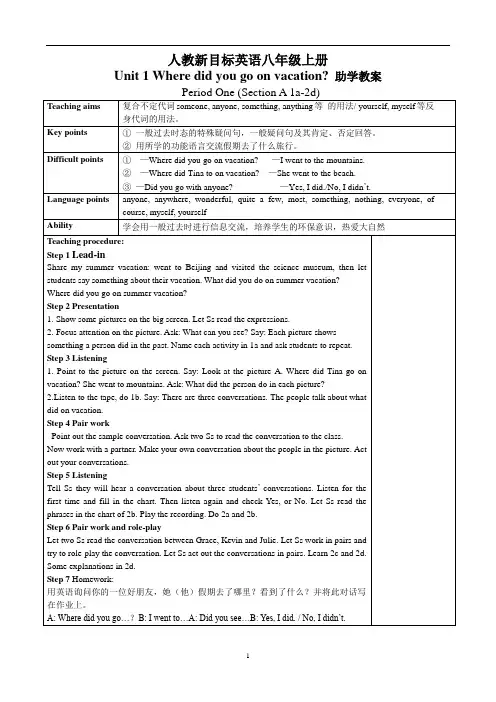
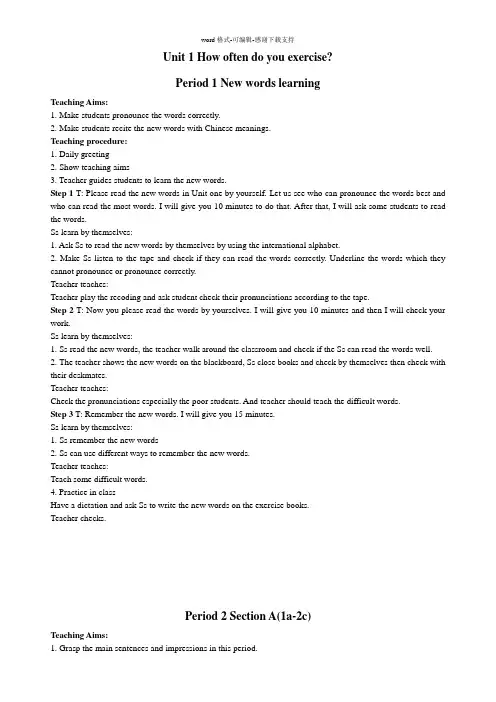
Unit 1 How often do you exercise?Period 1 New words learningTeaching Aims:1. Make students pronounce the words correctly.2. Make students recite the new words with Chinese meanings.Teaching procedure:1. Daily greeting2. Show teaching aims3. Teacher guides students to learn the new words.Step 1 T: Please read the new words in Unit one by yourself. Let us see who can pronounce the words best and who can read the most words. I will give you 10 minutes to do that. After that, I will ask some students to read the words.Ss learn by themselves:1. Ask Ss to read the new words by themselves by using the international alphabet.2. Make Ss listen to the tape and check if they can read the words correctly. Underline the words which they cannot pronounce or pronounce correctly.Teacher teaches:Teacher play the recoding and ask student check their pronunciations according to the tape.Step 2 T: Now you please read the words by yourselves. I will give you 10 minutes and then I will check your work.Ss learn by themselves:1. Ss read the new words, the teacher walk around the classroom and check if the Ss can read the words well.2. The teacher shows the new words on the blackboard, Ss close books and check by themselves then check with their deskmates.Teacher teaches:Check the pronunciations especially the poor students. And teacher should teach the difficult words.Step 3 T: Remember the new words. I will give you 15 minutes.Ss learn by themselves:1. Ss remember the new words2. Ss can use different ways to remember the new words.Teacher teaches:Teach some difficult words.4. Practice in classHave a dictation and ask Ss to write the new words on the exercise books.Teacher checks.Period 2 Section A(1a-2c)Teaching Aims:1. Grasp the main sentences and impressions in this period.2. Use the sentences to talk about how often you do things.Teaching procedureStep1. Daily greeting and show teaching aims. (1’)Step 2 PresentationComplete Activity 1a. (6’)1. First let the Ss discuss the picture and then ask the students to make a list of the different weekendactivities2. Next let two students talk about their own weekend activities and them tell their activities.3. Finally the teacher writes the activities on the blackboard. Teach them and let the students read loudly. Step 3 Listening practice. (8’)1. Listen to 1b twice. Write the letters from the picture. After listening ,learn the 6 words and introducethese words.2. Listen again and repeat loudly.3. Ss read loudly the listening materials for 3 minutes.Step 4 Present conversations.(5’)1. Read the conversation in pairsA: What do you usually do on weekends? B:I usually go to the movies.A: How often do you watch TV? B:I watch TV once a week .2. Make the new conversations.Step 5 Listening practice. (8’)1. Listen to 2a and 2b twice. First number the activities , then match the activities with the number of times.2. Listen again and repeat loudly (open)3. Ss read loudly the listening materials for 3 minutes.Step 6 Presentation(5’)Do Activity 2c.First let the Ss fill in the chart,then make their own dialogues according to the given conversation.Step 7 Class exersices:1)--____do you help the old man with the housework? --Once a week.A. How soonB. How longC. How oftenD. How many2) My mother _______surfs the Internet. She likes watching TV.A. doesn't hardly everB. hard everC. isn't hardly everD. hardly ever3) What are the _______ of your exams? A. answers B. problems C. results D. things4) -----What does she do on ________? -----She often go to the movies.A. Every weekB. a weekC. weekendD. weekends5) -------______do you do sports? --------I do sports every day.A. WhenB. What timeC. How longD. How often教學反思:Period 3 Section (3--4)Teaching Aims:1. Understand the main idea of this article.2. Learn to use the new words and expressions to talk about how often people do things.Teaching procedureStep 1. Daily greeting and show teaching aims. (1’)Step 2. Read the article carefully and fill in the blanks.(5’)Step 3. Read the passage again and underline some important words.(5’)Step 4. Read loudly alone for about 4 minutes. (4’)Step 5. Retell or recite (10’)Step 6. Discuss language difficulties in group to help each other.(5’)1. Discuss in groups2. Discuss in class3. The teacher explains.Step 7 Speaking and writing activities. (5’)Interview in groups and fill in the chart, then find out who is the best English student?Write a passage according to the filled chart.Step 8. Class exercisesA)根據句意,用括號內所給詞の適當形式填空。
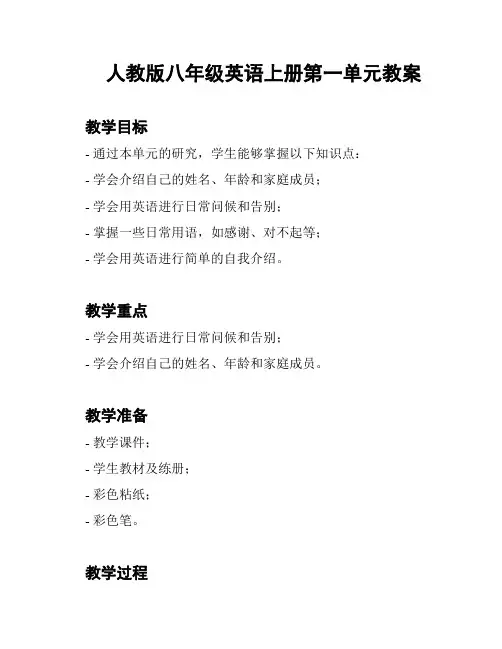
人教版八年级英语上册第一单元教案教学目标- 通过本单元的研究,学生能够掌握以下知识点:- 学会介绍自己的姓名、年龄和家庭成员;- 学会用英语进行日常问候和告别;- 掌握一些日常用语,如感谢、对不起等;- 学会用英语进行简单的自我介绍。
教学重点- 学会用英语进行日常问候和告别;- 学会介绍自己的姓名、年龄和家庭成员。
教学准备- 教学课件;- 学生教材及练册;- 彩色粘纸;- 彩色笔。
教学过程导入新课1. 利用图片或课件引导学生对英语问候和告别进行讨论,激发学生的兴趣。
研究新知2. 分小组让学生彼此进行问候和告别的练,引导正确的语音和语调。
新知讲解3. 通过课件或黑板,向学生介绍并教授以下句型:- What's your name? My name is [name].- How old are you? I'm [age] years old.- Who's this? This is my [family member].合作练4. 学生分组进行角色扮演练,模拟真实生活中的日常对话,并互相评价。
拓展延伸5. 让学生用英语进行简单的自我介绍,以加强他们的口语表达能力。
巩固练6. 学生根据教材中的练完成相关练题,巩固所学内容。
作业布置7. 布置学生的课后作业,包括完成学生教材的练和准备下节课的内容。
教学反思本节课通过多样化的教学方法,如导入新课、学习新知、合作练习等,让学生在积极参与中学习和巩固了英语问候和介绍自己的知识点。
同时,通过角色扮演和互相评价,培养了学生的口语表达能力和团队合作意识。
我将继续关注学生的学习情况,及时调整教学策略,使他们对英语学习更加感兴趣和自信。
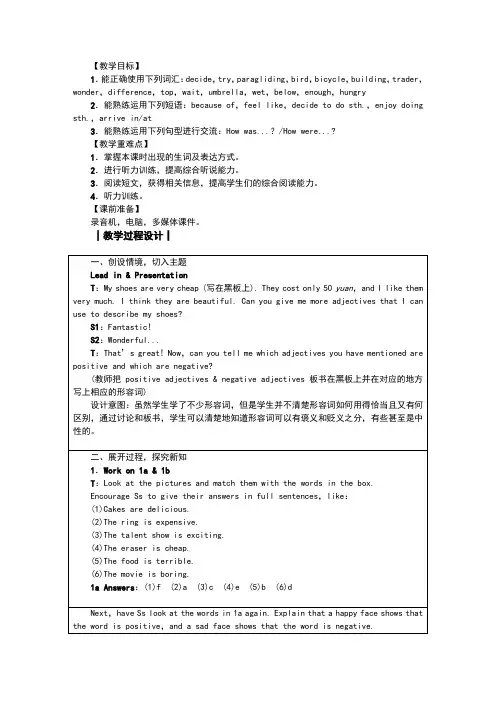

人教版八年级上册Unit 1 Where did you go on vacation?一、教材分析:本单元是八年级上册英语教材的第一个单元。
本单元的教学围绕“节日与假期”这个话题展开教学。
Section A 是通过谈论假期活动,首先让学生复习、巩固对一般过去时的理解及运用。
Section B由对假期活动的询问及叙述转向描述及谈论假期的感受;在语言上,除了进一步综合训练、巩固Section A所学重点语言内容外,学习正确、得体地运用相关形容词描绘假期活动,表达自己的感受成为这一部分的一项重要任务;在语言技能上,则由听说转向综合性地听、读、写的训练。
本单元共有阅读类文章一篇,文章的主体时态都为一般过去时。
主要句型为:Where did you go on vacation? Did you go out with anyone? How was the food? etc.二、教学目标:1.知识目标:1)掌握一般过去时的用法;2)掌握规则动词和不规则动词过去式的构成;3)掌握不定代词的用法;something, anything, someone等;4)掌握表示“到达” 的arrive in, arrive at, get to与reach的区别以及用法;5)掌握feel like doing sth./decide to do sth./too many与too much\enough的用法;6)掌握以下主要句型:“ Where did you go on vacation?” “I went to......”“Did you go out with anyone?” “No. No one was here. Everyone was on vacation.”“Did you buy anything special?” “Yes, I bought something for my father./No, I bought nothing.” “How was the food?” “Everything tasted really good!”“Did everyone have a good time?” “Everything was excellent.”2.能力目标:1)能够用英语谈论某人的假期经历以及如何用英语写一篇旅行日记。
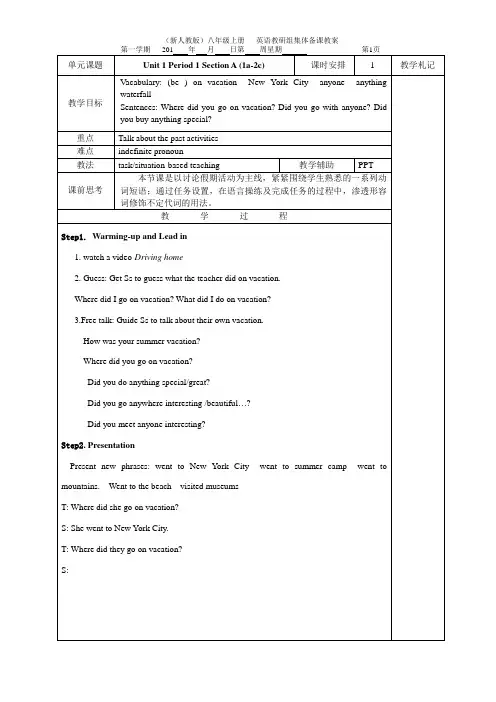
单元课题Unit 4 What’s the best movie theatre?语法归纳Unit 4教学札记形容词的比较级和最高级(二)1. 形容词的比较级和最高级的用法(1)形容词比较级用于两者(人或物)之间的比较,表示一方比另一方“更……”或“较……”,后面通常用比较连词than连接另一方所比较的人或物。
than引导的是比较状语从句,但为了避免重复,从句中有些与主句相同的部分常常省略,而把相比较的部分省略出来。
另外,在上下文明确时,形容词比较级也可以单独使用。
例如:This room is smaller than that one (is). 这个房间比那个房间小。
He is younger than I(am). 他年纪比我小。
His English is better than his brother 's (is). 他的英语比他哥哥的好。
1.形容词最高级用于三者或三者以上的人或事物之间的比较,表示其中一方在三者以上的人或事物中“最……”。
最高级前通常用定冠词the, 并用of或in短语来说明比较的范围。
Of后面一般接表示同类的名词,in接表示范围的名词。
例如:He is the tallest of all. 他是所有人中最高的。
Li Hua is the best student in his class. 李华是他班上最好的学生。
2.比较级与最高级的区别与联系(1)比较级是用来把彼此独立的适合人进行比较;最高级是把一个群体中的一员与整体进行比较,这个群体必须包括这个成员,请看下面例句:(A)Mary is taller than her two sisters. 玛丽比她的两个姐姐高。
(B)Mary is the tallest of the girls. 玛丽是这些女孩中最高的。
【注意】句(A)中玛丽是在另外两个姐妹之外,是玛丽一个人同另外两姐妹(作为一方)来比较,所以用比较级。
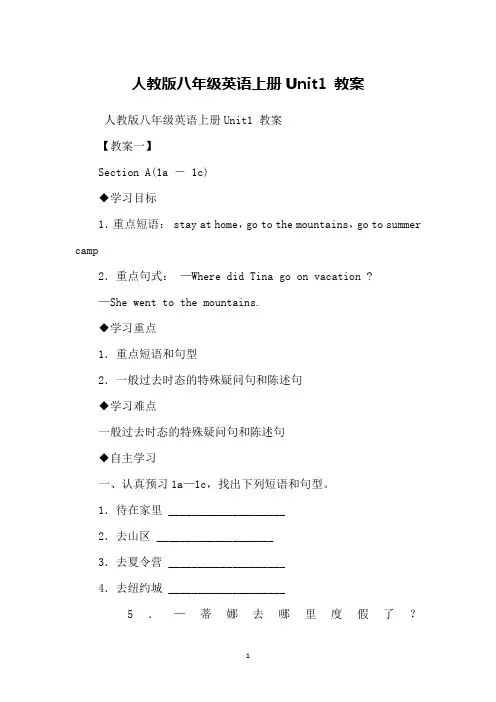
人教版八年级英语上册Unit1 教案人教版八年级英语上册Unit1 教案【教案一】Section A(1a - 1c)◆学习目标1.重点短语: stay at home,go to the mountains,go to summer camp2.重点句式:—Where did Tina go on vacation ?—She went to the mountains.◆学习重点1.重点短语和句型2.一般过去时态的特殊疑问句和陈述句◆学习难点一般过去时态的特殊疑问句和陈述句◆自主学习一、认真预习1a—1c,找出下列短语和句型。
1.待在家里 ____________________2.去山区 ____________________3.去夏令营 ____________________4.去纽约城 ____________________5.—蒂娜去哪里度假了?___________________________________________________________ _____—她去山区了。
___________________________________________________________ _____________◆课堂导学Step 1情景导入Teacher:Hello,everyone.Glad to see you again.Did you have a good time during the vacation? Did you go anywhere interesting with your parents? Did you do anything special there? Can you tell us where you went on vacation ?环节说明:以学生假期旅行为话题开始本节课的教学,引起了学生的学习兴趣和用英语表达的欲望。
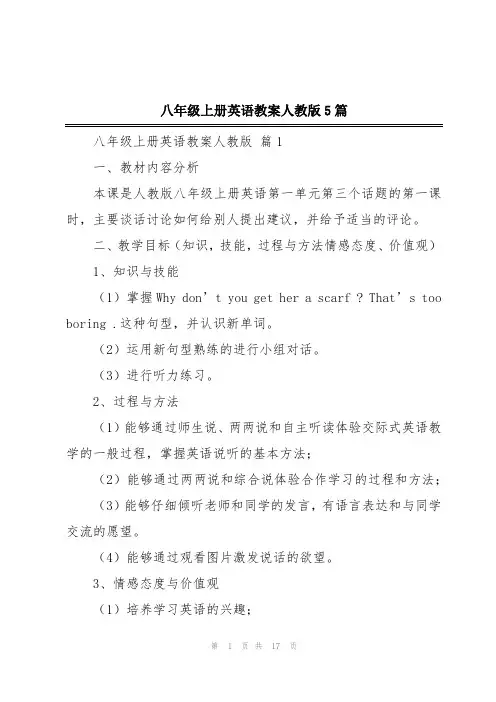
八年级上册英语教案人教版5篇八年级上册英语教案人教版篇1一、教材内容分析本课是人教版八年级上册英语第一单元第三个话题的第一课时,主要谈话讨论如何给别人提出建议,并给予适当的评论。
二、教学目标(知识,技能,过程与方法情感态度、价值观)1、知识与技能(1)掌握Why don’t you get her a scarf ? That’s too boring .这种句型,并认识新单词。
(2)运用新句型熟练的进行小组对话。
(3)进行听力练习。
2、过程与方法(1)能够通过师生说、两两说和自主听读体验交际式英语教学的一般过程,掌握英语说听的基本方法;(2)能够通过两两说和综合说体验合作学习的过程和方法;(3)能够仔细倾听老师和同学的发言,有语言表达和与同学交流的愿望。
(4)能够通过观看图片激发说话的欲望。
3、情感态度与价值观(1)培养学习英语的兴趣;(2)在学生两两交流和小组合作交流中,培养孩子合作意识和合作精神,能够相互配合完成一段通顺流畅的说话训练;(3)使学生学会礼貌待人。
三、学习者特征分析1、学生是八年级的学生。
2、学生已经学习了camera、hat,flowers 等物品的词。
3、学生对 great,interesting,boring 这些评论性的词非常熟悉。
4、学生好奇心强,对送什么礼物很感兴趣。
5、学生善于表现自己,乐于交际。
6、学生的听力能力不够强。
四、教学策略选择与设计1、谈话策略:运用谈话法引入新课。
2、自主听读策略:学生通过自主听读拓展材料,在完成课标要求的基础上训练听说能力,积累和丰富英语词汇和句式。
3、角色扮演法:让学生通过扮演不同角色,小组对话练习熟练地掌握重点句型。
五、教学环境及资源准备1多媒体教室。
2 本课教材,课件。
六、教学过程教学过程教师活动学生活动设计意图及资源准备Step1: Greeting Hello , cliass! How are you! Are you happy ... Greeting. 拉近教师和学生的距离。

Unit 1 How often do you exercise?Ⅰ.Teaching Aims and Demands1.Knowledge ObjectsNames of activities.Adverbs of frequency.What do you usually do on weekends?—I often go to the movies.2.Ability ObjectsWriting skill.Listening skill.Communicative competence.3.Moral ObjectTake exerciseⅡ.Teaching Key Points◆what does she do on weekends?—She often goes to the movies.◆How often do you exercise?—Three times a weekⅢ.Teaching MethodsDiscover method.Listening and writing methods.Pairwork.Ⅳ.Teaching AidsA tape recorder.Large monthly calendar showing the days of the week.A projector.Ⅴ.Teaching ProceduresStep Ⅰ Greet the classStep Ⅱ Section A 1a (This activity introduces the key vocabulary.)●Look at the picture. Ask a few students to say what they see in thethought bubbles. Each thought bubble shows something that a person does on weekends.●Name each activity. Ask students to repeat each one.Saying,One girl isshopping.Another girl is reading.This boy is exercising.Another boy is watching TV.These girls are skateboarding.●Point out the sample answer.Then ask the students to list all theactivities in the thought bubbles.They can use bilingual dictionaries to help tnem.Ask the student who finishes first to write the answers on the board.●Check the answers on the board and ask students to correct their ownactivities.Answers:watching TV readingskateboarding exercisingshoppingStep Ⅲ1b This activity gives students practice in understanding the target language in spoken conversation.●Point to each scene in Activity. Ask students to look at each pictureand tell what the person does on weekends.●Play the recording the first time.Students only listen.●Play the recording a second time.Point to the pictures.This timesay,Listen to the conversation.The people are talking about what they do on weekends.Listen to the recording and write the letter of one activity(a through e)after the word in the list.For example,on the recording someone says,I always go shopping.Shopping is a letter in the picture in activity 1a.So you put an“a”after the word always in this list.Repeat the explanation,if necessary.●Ask students to complete the activity individually.●Check the answers.Answersalways a usually coften e sometimes dhardly ever d never aTapescriptReporter: What do you usually do on weekends?Boy 1: I usually exercise.Girl 1: I always go shopping.Boy 2: Eeeeew…I never go shopping. I can't stand shopping.Girl 2 : I often go skateboarding.Boy 2 : And I sometimes watch TV.Reporter: How about you?Girl 3: I hardly watch TV. I love reading.Reporter: Oh, why is that?Girl 3: Oh, I don't know. I guess I just like reading books.Step Ⅳ1c PairworkFirst,ask two students to read the sample in speech bubbles.What do you usually do on weekends ?I often go to the movies.Now work with a partner. Make your own conversation about the people in the picture. For example.Picture a:What does she do on weekends ?She often goes shopping.Then have students work in pairs. Make their own conversations about the people in the picture. Then ask some pairs to present their conversations to theclass.Picture b:What does she do on weekends?She often does reading.Picture c:What does he usually do on weekends?He often does exercise.Picture d:What does he usually do on weekends?He often watches TV.Picture e:What do they usually do on weekends?They often do skateboarding.Step ⅤSummary and HomeworkThis class we've learnt some names of activities…keep a weekend diary showing what you do on weekend. You can write down what they do from the time you get up to the time you go to sleep. You can use a dictionary to learn new vocabulary words if necessary. I'll ask you to read your diaries to the class.。
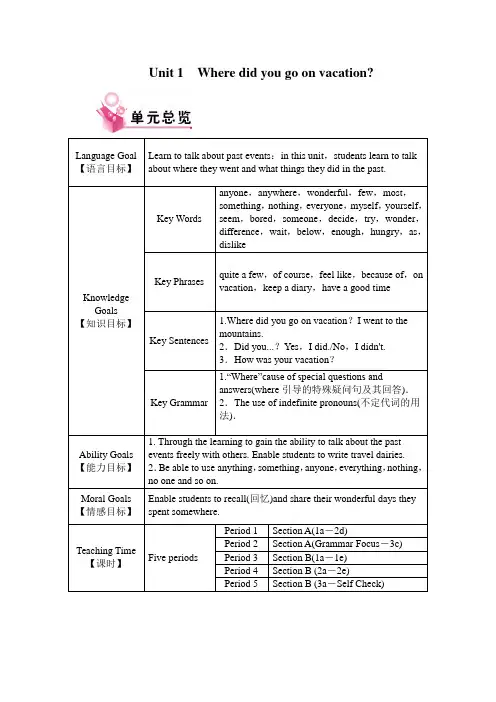
Unit 1Where did you go on vacation?本单元教材以Where did you go on vacation?为中心话题,围绕着描述“过去发生的事情”展开,学习和运用一般过去时态的一般疑问句Did you go/see/buy...?和特殊疑问句Where/What/How...?询问过去的事件,让学生学会谈论和分享过去发生的事件。
本课教学内容与学生的实际生活密切相关,易于引发学生运用简单的英语进行交流。
在学习活动中,学生通过交换对过去发生的事情的描述及看法,促进学生之间和师生之间的情感交流,增进情谊。
Section A的主要学习内容是:复习一般过去时态和动词的规则与不规则变化,学习一般过去时态的一般疑问句:Did you...?及不定代词的用法。
Section B安排了许多听、说、读、写的任务活动,教师在教学中可以灵活运用这些活动,将其中的一些活动进行变化或整合,充分调动学生参与的积极性,提高学生的听说读写能力。
第一课时Section A(1a-2d)Teaching Goals【教学目标】Key words & phrases:anyone,anywhere,wonderful,few,most,quite a few,go on vacationKey sentences:1.Where did you go on vacation?I went to the mountains/New York City/summer camp/the beach.2.Did you...?Yes,I did./No,I didn't.Teaching Key Points【教学重点】The vocabulary:New York City,Central Park,few,most,quite a few,on vacationTarget language:Where did you/they/he/she go on vacation?I/They/He/She went to the mountains/New York City/summer camp/the beach. Did you...?Yes,I did./No,I didn't.Teaching Difficult Points【教学难点】Use the target language above to talk about past events.Teaching Aids【教学工具】An English textbook,a tape recorder,CAI or courseware.Teaching Steps【教学过程】★Step 1Leading inGreet the class and introduce what to learn in this period.Teacher:Welcome back to school!Did everyone have a good time during the summer vacation?Today we'll begin to learn the topic where you went on vacation.Teacher:Where did you go on vacation?Students:______.①I went to the mountains.②I visited museums.…★Step 2Pre-taskPage 1,1a & 1b.1.Look at the picture.2.Match each activity.3.Check the answers in 1b.4.Practice reading.Page 1,1c.1.Focus on the conversation in the box.2.Practice reading.3.Pairwork:Where did you go on vacation?I...4.Groupwork:Divide the class into groups of four or five. Make conversations.First S1 to S2:S1:Where did you go on vacation?S2:I...S1:Where did she/he go on vacation?S2:She/He...★Step 3While-taskPage 2,2a & 2b.1.Play the recording for the first time. Students complete the chart in 2a.2.Check the answers.(Point to one student who raises his or her hand.)3.Play the recording a second time and say:There are three conversations. The people talk about where they went on vacation. Listen to the recording and check(√)Yes,I did or No,I didn't for each question.4.Correct the answers.★Step 4Post-taskPage 2,2c & 2d.1.Focus on the conversation in 2c & 2d.2.Practice reading. Make students scan the conversations first.3.Teach and then make students role-play the conversation in pairs.4.Have a group of students present their conversation to the class.★Step 5Homework1.Practice the conversation on Page 2,2d.2.Do the exercises on Page 1 in students' book.Board Design板书设计Unit 1Where did you go on vacation?The first period Section A(1a-2d)1.Key vocabulary:anyone,anywhere,wonderful,quite a few,go on vacation 2.Target language:A:Where did Tina go on vacation?B:She went to the mountains.第二课时Section A(GF-3c)Teaching Goals【教学目标】Key words:something,nothing,everyone,myself,yourself,someone,seem,bored,diaryKey phrases:go out,have a good time,of course,keep a diaryKey sentences:1.Where did you go on vacation?I went to New York City.2.Did you go out with anyone?Did you buy anything special?3.How was the food?How was your vacation?Teaching Key Points【教学重点】The vocabulary:something,nothing,everyone,myself,yourself,someone,seem,bored,diary,go out,have a good time,of course,keep a diary,on vacation Target language:How was the food?Everything tasted really good!Did you go shopping?Of course!Did everyone have a good time?Oh,yes. Everything was excellent.Teaching Difficult Points【教学难点】e the target language above to talk about past events.2.The usage of someone,anyone,everyone,no one,something,anything,everything,nothing.Teaching Aids【教学工具】An English textbook,CAI or courseware.Teaching Steps【教学过程】★Step 1Leading in(T—teacher S—student)T:Where did you go last weekend?S:I went to the beach.T:Did you go there with anyone?S:Yes. I went to the beach with my brother.T:Did you have a good time there?S:...★Step 2Pre-taskPage 3,Grammar Focus.1.Review the grammar box. Work in pairs. One asks and the other answers.2.Practice reading the sentences in the chart.★Step 3While-taskPage 3,3a & 3b.1.Teach these new words:anyone,something,anything,everything,nothing,everyone,no one.2.Call students' attention to the conversation in 3a. Make students complete it individually.3.Choose a student to give his or her answers. Write the answers on the board.4.Correct the answers.5.Lead students to read this conversation.6.Have students work in pairs and role-play the conversation. As they talk,move around the classroom monitoring their work. Offer language or pronunciation support as needed.7.Make students complete the blanks in the e-mail message in 3b with the words in the box.8.Check the answers and then make students practice reading it.★Step 4Post-taskPage 3,3c.Complete the task in 3c.Ask your group questions about their last vacation. Then tell the class your results.★Step 5Homework1.Review the indefinite pronouns learned in this period.2.Do the exercises on Page 2 in students' book.Board Design板书设计Unit 1Where did you go on vacation?The second period Section A(GF-3c)1.The vocabulary:something,nothing,everyone,someone,myself,yourself,go out,of course2.Target language:①A:Where did you go on vacation?B:I went to New York City.②A:Did you buy anything special?B:Yes,I bought something for my father.3.Structure:something special4.Answers to 3a and 3b.第三课时Section B(1a-1e)Teaching Goals【教学目标】Key words:delicious,exciting,terrible,expensive,cheap,boringKey sentences:1.Where did Lisa go on vacation?2.Did she do anything special there?Did she buy anything for her best friend?Did Lisa like her vacation?3.How was/were...?Teaching Key Points【教学重点】The vocabulary:delicious,exciting,terrible,expensive,cheap,boringTarget language:Where did Lisa go on vacation?Did she do anything special there?Did she buy anything for her best friend?How was/were...?Teaching Difficult Points【教学难点】1.询问去过何地以及感受(评价)Where did you go?I went to the beaches. How was it?It was exciting.2.Use the target language to talk about your past events.Teaching Aids【教学工具】An English textbook,a tape recorder,CAI or courseware.Teaching Steps【教学过程】★Step 1Leading in1.Greetings.2.T:Where did you go on vacation?S:I went to summer camp.T:Did you do anything special there?S:Yes,I...T:Did you buy anything for your parents or friends?S:Yes,I bought...for.../No,I bought nothing.T:How was/were...?S:It was/They were...★Step 2Pre-taskPage 4,1a & 1b.1.Look at the six pictures.2.Match the words with the pictures.3.Students complete the task in 1b individually.4.Check the answers.★Step 3While-taskPage 4,1c & 1d.1.Make students scan the questions in 1c.2.Play the recording for the first time. And say:Listen to the tape. Lisa is talking about her vacation. Complete the four questions.3.Play the recording a second time. Students complete the task in 1d.4.Correct the answers.★Step 4Post-taskPage 4,1e.Ask 3 or 4 students to answer questions about Lisa's vacation. You can begin your questions with:Where did...?What did...?Did she...?How was...?How were...?★Step 5Homework1.Review these sentences:Where did...?Did...?How was/were...?2.Do the exercises on Page 3 in students' book.Board Design板书设计Unit 1Where did you go on vacation?The third period Section B(1a-1e)1.Words:delicious,exciting,terrible,expensive,cheap,boring2.Sentences:①Where did Lisa go on vacation?②Did she buy anything special?③Did she buy anything for her best friend?④Did Lisa like her vacation?3.Answers to Activity 1a:1—5f a c e b dAnswers to Activity 1b:wordsdeliciousexcitingcheapwordsterribleexpensiveboring第四课时Section B(2a-2e)Teaching Goals【教学目标】Key words:activity,decide,try,bird,bicycle,building,trader,wonder,difference,top,wait,umbrella,wet,below,enough,hungry,asKey phrases:feel like,because of,go to the beach,a lot of,a little,take the train,too many,what aboutKey sentences:1.I wonder what life was like here in the past.2.What a difference a day makes!3.We waited over an hour for the train because there were too many people.Teaching Key Points【教学重点】Learn Jane's diary entries about her vacation.1.The vocabulary:activity,decide,try,wonder,difference,wait,below,enough,hungry,as,feel like,because of2.Target language:I wonder what life was like here in the past. We waited over an hour for the train because there were too many people.Teaching Difficult Points【教学难点】1.because and because of2.What a difference a day makes!3.Learn to write a diary.Teaching Aids【教学工具】An English textbook,CAI or courseware.Teaching Steps【教学过程】★Step 1Leading in1.Greetings.2.Introduce what to learn in this period,especially the articles in 2b,Jane's diary entries. Teacher begins like this:Today we'll focus on two diary entries about Jane's vacation. Through the learning you'll know how to write a diary. Let's begin now.★Step 2Pre-taskPage 5,2a & 2b.1.Review and discuss the questions in 2a box with your partner.2.Project these new words on the screen or write them on the board and teach the new words. Ask students to repeat them. And make sure everyone knows the meanings.activity n.活动;decide v.决定;try v. & n.尝试,设法;wonder v.想知道;difference n.差异;top n.顶部;wait v. & n.等待;umbrella n.伞;below prep.& adv.在……下面;enough adj.充足的;hungry adj.饥饿的3.Make students scan the articles first. Ask students to put a mark in contents that are unfamiliar to them. Then the teacher lead students to learn these two articles sentence by sentence. Pay attention to these points:(1)decide v.决定;decide to do sth.决定做某事;(2)try v.尝试;try doing sth.尝试做某事;try to do sth.尽力做某事;(3)below prep. & adv.在……下面;(4)feel like 给……的感觉;(5)because and because of;(6)wonder v.想知道4.Practice reading.★Step 3While-taskPage 6,2c & 2d.1.Make students read Jane's diary entries again. Fill in the chart in 2c.2.Students complete the conversation in 2d using the information in Jane's dairy entries.3.Choose 3 or 4 students to give their answers.4.Correct the answers.5.Have students work in pairs. Student A will be Anna and student B will be Jane. Act the conversation out.★Step 4Post-taskPage 6,2e.1.Make students complete the blanks in 2e.2.Ask one student to write his or her answers on the board.3.Check the answers together with the class.4.Practice reading.★Step 5Homework1.Write a diary.2.Do the exercises on Page 4 in students' book.Board Design板书设计Unit 1Where did you go on vacation?The fourth period Section B(2a—2e)1.Key vocabulary:decide,try,wonder,difference,top,wait,below,enough,hungry,as,feel like,because of,too many2.Sentences:①I wonder what life was like here in the past.②And because of the bad weather,we couldn't see anything below.第五课时Section B(3a-Self Check)Teaching Goals【教学目标】Key words & phrases:duck,dislike,take photos,Tian'anmen Square,the Palace Museum,bring back,shopping center,have a fun time,school trip,come upKey sentences:1.How did you feel about the trip?2.It was so beautiful that we forgot about the last five hours!Teaching Key Points【教学重点】The vocabulary:dislike,take photos,Tian'anmen Square,the Palace MuseumTarget language:What did you like best?Did you dislike anything?How did you feel about the trip?Teaching Difficult Points【教学难点】Write a travel diary.Teaching Aids【教学工具】An English textbook,CAI or courseware.Teaching Steps【教学过程】★Step 1Leading in1.Greetings.2.T:Beijing is the capital of our country. It's famous for its long history and places of interest,such as Tian'anmen Square,the Palace Museum,the Summer Palace and so on. And Beijing duck is very delicious. Have you ever been to Beijing?Tell your travel to us.★Step 2Pre-taskPage 7,3a.1.Look at the three pictures.2.Use the words and phrases in the box to complete the blanks in the article.3.Check the answers.★Step 3While-taskPage 8,Self Check.Complete the tasks in Self Check.1.Have students complete the task of Part 1.Then Choose 2 or 3 students to give their answers. Check the answers.2.Induct students to complete the passage of Part 2.Check the answers.3.Practice reading.★Step 4Post-taskPage 7,3b & 3c.1.Make students answer the questions in 3b and take notes.2.Teach students how to write a travel diary.3.Students write a travel diary like Jane's on Page 5 using the notes in 3b.4.Choose 2 or 3 students' diaries. Make students read them out. Point out the weakness and induct the students to correct their diaries.★Step 5Homework1.Write a travel diary.2.Do the exercises on Page 5 in students' book.Board Design板书设计Unit 1Where did you go on vacation?The fifth period Section B(3a-Self Check)1.Key vocabulary:dislike,Tian'anmen Square,the Palace Museum,have a fun time,come up2.Sentences:①Did you dislike anything?②How did you feel about the trip?③My legs were so tired that I wanted to stop.。
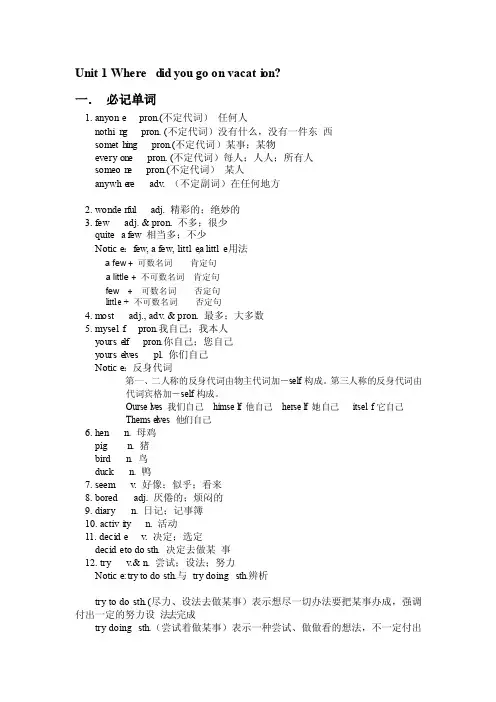
Unit 1 Wheredid you go on vacati on?一.必记单词1. anyone pron.(不定代词)任何人nothin g pron. (不定代词)没有什么,没有一件东西someth ing pron.(不定代词)某事;某物everyon e pron. (不定代词)每人;人人;所有人someon e pron.(不定代词)某人anywhe re adv. (不定副词)在任何地方2. wonderful adj. 精彩的;绝妙的3. few adj. & pron. 不多;很少quite a few 相当多;不少Notice:few, a few, little,a little用法a few + 可数名词肯定句a little + 不可数名词肯定句few + 可数名词否定句little + 不可数名词否定句4. most adj., adv. & pron. 最多;大多数5. myself pron.我自己;我本人yourse lf pron.你自己;您自己yourse lvespl. 你们自己Notice:反身代词第一、二人称的反身代词由物主代词加-self构成。
第三人称的反身代词由代词宾格加-self构成。
Oursel ves 我们自己himsel f 他自己hersel f 她自己itself它自己Themsel ves他们自己6. hen n. 母鸡pig n. 猪bird n. 鸟duck n. 鸭7. seem v. 好像;似乎;看来8. boredadj. 厌倦的;烦闷的9. diaryn. 日记;记事簿10. activi ty n. 活动11. decide v. 决定;选定decide to do sth. 决定去做某事12. try v.& n. 尝试;设法;努力Notice: try to do sth.与try doingsth.辨析try to do sth.(尽力、设法去做某事)表示想尽一切办法要把某事办成,强调付出一定的努力设法去完成try doingsth.(尝试着做某事)表示一种尝试、做做看的想法,不一定付出很多努力Eg.: I tried calli n g him, but no one answe red. I ’m tryin g to learn Engli s h well. 13. bicyc l e n. 自行车;脚踏车 14. build i ng n. 建筑物;房子 Notic e: build (建造,建筑)+ ing ==== build i ng(建筑物) build (建造,建筑)+ er ==== build e r(建设者,建筑者) 15. trade r n. 商人 16. wonde r v . 想知道;琢磨 17. diffe r ence n. 差别;差异 ( diffe rent adj. 不同的,有差异的) 18. top n. 顶部;表面19. wait v . 等待;等候 (wait for sb./sth. 等待某人/某物) 20. umbre lla n. 伞;雨伞21. wet adj. 湿的;潮湿的;下雨的 22. below prep.& adv . 在···下面;到···下面 反义词 above 超过;在···之上 23. enoug h adj. & adv . 足够的(地);充足的(地);充分的(地) 巧记eno u gh 在句中的位置:修饰名词很自由,可以前来也可后, 若是修饰形或副,一定后置要记住。
Teaching Plan for Lesson 3, Unit 1 (Go for It Book 3)The Third Period, Reading: “The healthy life”I. Teaching Objectives1. Language Objectives(1) Important words and phrasesjunk food, milk, coffee, drink, health, interview, how many, how often.(2) Important sentence patternsa. How often do you drink milk?b. How many hours do you sleep everyday night?c. How often do you eat junk food?2. Ability Objectives(1) Learn to gain the information from the pictures, and then answer the questions.(2) Train students’ reading ability.3. Moral Objectives(1) Enable students to have a healthy life by learning the text.(2) Enable students to form good habits and get out of bad habits, and then be aware of the junk food and healthy food.II. Important Points1. How to use “How often…” to ask the questions and then how to answer the questions.2. How to grasp the key words and phrases to answer the questions.III. Difficult Points1. How to use “How often…” to ask questions.2. How to get the answers to the questions.IV. Teaching Methods1. Listening, reading, discussing, asking and answering, pictures, pair work, explaining.2. Teaching Aids: a tape recorder, pictures.V. Teaching ProceduresStep I Greeting (1 min)Greet the whole class as usual.T: Now class begins. Good morning, class.S: Good morning, julin.T: Sit down, please.I’m very happy to see you again.Welcome to my class.Step II Lead-in (2mins)Ask some students to say something about their own daily life.T: As we all know, we need to eat and drink something to stay alive. Before our class begins,I want to know something about you. What do you usually eat every day?S1: I eat rice and meat every day.T: Ok, very good! What did you eat this morning.S2: I ate noodles this morning.T:Great.It’s very important for us to have breakfast.And how about you?T3:I ate gruel this morningT:Good,all of us have breakfast everyday and should keep the good habitsT: Ok! Today we will learn more about food and drink. Now let’s turn to page 4.And we will learn section B: Healthy life.Step III Words(3mins)Show some pictures to the students and then teach students the new words. Asksome students to match each word with a picture.T: Here are some pictures. Let’s look at them, and guess how to say them in English. I read them and then you will repeat. What’s this? Do you like it?S: Yes.T: how to say it in English?S:HamburgerT:Yes,this is a hamburger,this is a kind of junk food.Read after me: junk food.Ss: junk foodT: And what’s this? Did you drink it this morning?It’s milk.Many people drink it every day. It can make us strong, right? Follow me, milk.Ss: milkT: What can you see in this picture? They are so fresh. And we eat them every day. It’s vegetable.Follow me: Vegetable.S: Vegetable.T:What’s this?There are some peaches,grapes,bananas and so on.If we put them together,how can we say them in English?It’s fruit.Many people eat it everyday.It can make us healthy.Right?Follow me,fruitS:FruitT:Do yo like to play gamesS:yesT:Now let’s play games.The game is that I put 4 pictures on the blackboard and you match the words with the pictures on the blackboard.Do you understand?S:YesT:Who want to have a try?(Student do the game on the blackboard)T: Ok, now let’s check the answer. Is she/he right?Ss: Yes.T: Give her a big hand.Step IV Explanation (5 mins)Ask two students to read the dialogue first and then explain the phrase “be good for”to students.T: Now I will invite two students to read the dialogue in 1b.(Two students read the dialogue)T: There is a phrase “be good for” in the last sentence. Do you know its meaning?Don’t worry. Now I will explain it to you. The phrase “be good for” means “to have a usefuleffect, to help somebody”Here is a sentence “Milk is good for our health”.Can you make another sentence by using this phrase?Who want have a try on the blackboard? S1: Banana is good for our health.T: Is she right?S:Yes.Good! How about others?S2: Orange is good for our body.T: Yes!But how about junk food?Ss: It’s not good for our health.T: Good! Can you say it in another way? We can say: “ Junk food is bad for our health.”The phrase “be bad for” is equal to the phrase “be not good for”.So the phrase “be bad for” is opposite of the phrase “be good for”.You can guess the meaning of the phrase “be bad for”. The phrase “be bad for” means :harmful causing or likely cause damageAre you clear?Ss: Yes.T:Can you make a setence by using this phrase?S:Ice cream is bad for our healthT:you are so smartStep V Pair work (4mins)Students make their own conversations in pairs.T: Now. You have understood the phrase “be good for”. Here I will give you several minutes to make your own conversations in pairs. You can use the sentences in 1b and then I will invite some students to play their conversations out.(Students make their conversations)T: Would you like to show your conversation to us?S1: How often do you eat junk food?S2: I eat junk food just once a week.S1: Do you like it?S2: Of course. But my mum says it’s bad for my health, so I shouldn’t eat it quiteoften.T: Good job! Junk food is not good for our health. We’d better not eat it, right?Ss: Yes!T: How about other pairs? Do you want to have a try?S3: How often do you eat vegetables?S4: Every day.S3: Why?S4: Because it is good for our health.T: Good! You have done a good job.Step VI Listening (5 mins)1.Students listen to the tape for the first time and answer the questions in 2a.T: What is healthy? If I never exercise and eat a lot of junk food, am I healthy?Ss: No.T: If I eat lots of fruits and vegetables and exercise every day, am I healthy?Ss: Yes.T: Now listen to the recording and decide if Bill or Katrina is healthy? Circle “yes”, “no”, or “ I don’t know” in 2a.And fill in the blank in 2b.(Play the recording)T: Ok, now let’s check the answers.Look at the sample answer under Katrina’s name and the answer is every day. I hope all of you get the answers in 2b. Please speak out your answer oneby one.(stuents answer questions)T: You all did a good job.Step VII Summary (1min)Ask some students to say what they have learned and let them know what they should do in the future.T: What have you learned from this class?S1: I have learned that we should eat vegetable and fruit every day. And they are good for our health.T: How about others?S2: We shouldn’t eat junk food or drink coffee quite often. We need to sleep about nine hours every night.T: Yes, good! You should form good habits and get out of bad habits, so that youcan have a healthy life, right?Ss: Yes.Step VIII Homework1.Practice the sentences just learnt2.Write and recite the words on Page 4.。
人教版义务教育教科书◎英语八年级上册Unit1Wheredidyougoonvacation?教材解读本单元的核心话题是用一般过去时谈论度假等发生在过去的事情。
因此“Wheredid yougoonvacation?〞“Didyougotothebeach?Yes,Idid/No,Ididn’t.〞等是教学的重点。
通过对本单元的学习,学生能掌握本单元出现的地点名词,用于询问和答复过去发生的事情的短语和句型。
单元目标一、知识与技能1.词汇:NewYorkCity,CentralPark,exam,were,rainy,delicious,expensive, inexpensive,crowded,flew,kite,later,felt,little,corner,discuss,etc.2.句型:Wheredidyougoonvacation?Iwenttosummercamp.DidshegotoCentralPark?Yes,shedid.No,shedidn.’t3.语法:一般过去时的特殊疑问句、一般疑问句及肯、否认答复。
4.能力目标:能用一般过去时熟练谈论假期发生的事。
二、过程与方法灵活运用教材,从所教学生的实际水平和语言能力出发,调整和取舍教学内容,合理安排本单元的课时数,设计好每课时的教学内容。
三、情感、态度与价值观1.通过描述假期发生的事,增进同学间的了解,增进感情。
2.通过图片和视频欣赏优美的风景,培养热爱祖国大好河山的思想感情,提高学生的环保意识。
3.了解自己的能力,培养情操4.培养学生们对英语的兴趣。
教法导航1.以任务型教学作为课堂教学理念、利用整体语言教学法、情景教学法、交际教学法等。
2.在教学中创设切实可行的任务型教学活动、突出交际性。
3.教师为主导、学生为主体、任务为根底,注重实用性。
4.引趣激趣策略,创设情景调节气氛,引发激发学生兴趣。
1教师备课系统──多媒体教案学法导航多读善思,小组合作、探究、学习、交流。
【能力目标】能够使用skimming和scanning阅读技巧找出文章的主要内容,并完成任务。
【情感目标】培养学生的阅读能力和语言表达能力,陶冶情操。
教学一般过去时态的各种句式。
重难点教学过程◆Step 1Leading inT:Good morning,class.Today we will learn Section B(1a-2e).First,let’s review what we learnedyesterday.Now let’s have a free talk.教学过程T:Where did you go on vacation?S:I went to summer camp.T:Did you do anything special there?S:Yes,I...T:Did you buy anything for your parents or friends?S:Yes,I bought...for.../No,I bought nothing.T:How was/were...?S:It was/They were...设计意图让学生做到温故知新。
◆Step 21a1.Look at the six pictures.2.Match the words with the pictures.3.Students complete the task in 1b individually.4.Check the answers.(见课件)◆Step 31bNow class,look at the words in 1a again.Which words do you think describe good things and which ones not.Let’s have a try.Try to write words on the left.Write words on the right.Check the answers.(见课件)◆Step 4 1c & 1d1.Ask students to scan the questions in 1c.2.Play the recording for the first time.And say:Listen to the tape.Lisa is talking about her plete the four questions.Unit 3 I’m more outgoing than my sister.Unit 4What’s the best movie theater?。
2024年人教版八年级英语上册教案全册完整版一、教学内容Unit 1 Where did you go on vacation?Unit 2 How often do you exercise?Unit 3 I'm more outgoing than my sister.Unit 4 What's the best movie theater?Unit 5 Do you want to watch a game show?二、教学目标1. 掌握并运用一般过去时、频率副词、形容词比较级和最高级等语法知识。
2. 提高学生的听说读写能力,尤其是日常对话和描述性句型的运用。
3. 培养学生的团队合作精神和批判性思维。
三、教学难点与重点1. 教学难点:一般过去时与频率副词的运用,形容词比较级和最高级的区分。
2. 教学重点:日常对话的听说读写能力,描述性句型的构建。
四、教具与学具准备1. 教具:PPT、录音机、黑板、教学卡片。
2. 学具:课本、练习本、彩笔。
五、教学过程1. 导入:通过展示学生感兴趣的旅游景点或活动图片,引发学生对Unit 1话题的兴趣。
2. 新课内容展示:讲解一般过去时,举例说明,引导学生进行对话练习。
3. 例题讲解:针对Unit 1的语法点,给出例题,并讲解解题过程。
4. 随堂练习:分组练习,让学生相互提问并回答假期经历。
6. 课堂延伸:以类似方式教授Units 25,注意结合各单元特点进行教学。
六、板书设计1. 板书八年级英语上册教案2. 板书内容:Unit 1: 一般过去时,频率副词Unit 2: 形容词比较级Unit 3: 形容词最高级Unit 4: 描述性句型Unit 5: 日常对话七、作业设计1. 作业题目:Write a short passage about your last vacation using the simple past tense.Compare two movie theaters in your city and explain which one is better.Make a survey about how often your classmates exercise and present the results.2. 答案:见附件。
新人教版八年级上册英语教案(全册) Unit 1 School lifeLesson 1 Where's the post office?Teaching objectives- Learn and master the new words: post office, bookstore, hotel, cinema, restaurant- Learn and master the new sentence pattern: Where is the post office?- Train the students' listening and speaking ability.Key points and difficult points- Key points: The usage of new words and sentence pattern.Teaching methods- Demonstration method.- Task-based language teaching method.Teaching aids- Multimedia courseware.Teaching procedures1. Warm-up.2. New lesson.3. Listening practice.4. Speaking practice.5. Summary and homework.Unit 2 Personal informationLesson 1 My name's Gina.Teaching objectives- Learn and master the new words: name, family name, given name, spell- Learn and master the new sentence pattern: What's your name? My name is Gina.- Train the students' listening and speaking ability.Key points and difficult points- Key points: The usage of new words and sentence pattern.Teaching methods- Situational method.- Task-based language teaching method.Teaching aids- Multimedia courseware.Teaching procedures1. Warm-up.2. New lesson.3. Listening practice.4. Speaking practice.5. Summary and homework.Lesson 2 Where are they from?Teaching objectives- Learn and master the new words: country, Australia, England, China- Learn and master the new sentence pattern: Where are you from? I'm from Australia.- Train the students' listening and speaking ability.Key points and difficult points- Key points: The usage of new words and sentence pattern.- Difficult points: How to ask and answer questions about where people are from.Teaching methods- Situational method.- Task-based language teaching method.Teaching aids- Multimedia courseware.Teaching procedures1. Warm-up.2. New lesson.3. Listening practice.4. Speaking practice.5. Summary and homework. ......。
Unit 1 Where did you go on vacation?Level: 8th gradeObjectives:To enable students to talk about past vacation experiences using past tense verbs.To encourage students to ask and answer questions using past tense.To develop students' listening and speaking skills through pair and group work.To enhance students' vocabulary related to travel and vacation.Materials:Textbook: New Target 8th grade English textbook, Unit 1.Handouts: Irregular verbs list and questions for pair work.Pictures of different travel destinations and modes of transportation.Procedure:Warm-upa. Greet the students and ask them how they are doing.b. Ask students to recall a memorable vacation they had and share their experience with their partner.c. Review the use of past tense verbs by asking students to identify the verbs in their vacation experiences.Presentationa. Introduce the topic of the lesson "Where did you go on vacation?" and show some pictures of different travel destinations and modes of transportation.b. Teach the past tense irregular verbs through the handouts provided.c. Model the use of past tense verbs in sentences by using the verb "go" and the students' vacation experiences. Example: I went to Hawaii with my family last summer.Practicea. Divide the class into pairs and give them the questions handout. The questions should focus on their vacation experiences. Example: Where did you go on your last vacation? Who did you go with? What did you do?b. Instruct the students to take turns asking and answering the questions using past tense.c. Monitor the pairs and provide feedback where necessary.Productiona. Divide the class into groups of 4-5 students.b. Instruct the students to plan a vacation to a specific destination and present it to the class using past tense.c. Encourage the students to use as many past tense verbs as possible in their presentation.d. Allow the students to present their vacation plan to the class and give feedback.Conclusiona. Summarize the lesson by asking the students to recall the use of past tense verbs.b. Ask the students to share what they have learned in the lesson.c. Assign homework, which could be to write a paragraph about their dream vacation using past tense.Assessment:The teacher can assess the students' understanding of the lesson through their participation in the pair and group work. The students' use of past tense verbs and their ability to ask and answer questions will be evaluated. The homework assigned will also be assessed for the students' use of past tense.。
Unit 1 Where did you go on vacation?教材解读本单元的核心话题是用一般过去时谈论度假等发生在过去的事情。
因此“Where did you go on vacation?”“Did you go to the beach? Yes,I did / No,I didn’t.”等是教学的重点。
通过对本单元的学习,学生能掌握本单元出现的地点名词,用于询问和回答过去发生的事情的短语和句型。
单元目标一、知识与技能1. 词汇:New York City, Central Park, exam, were, rainy, delicious,expensive, inexpensive, crowded, flew, kite, later, felt, little, corner, discuss, etc.2. 句型: Where did you go on vacation? I went to summer camp.Did she go to Central Park?Yes, she did.No, she didn’t.3. 语法:一般过去时的特殊疑问句、一般疑问句及肯、否定回答。
4. 能力目标:能用一般过去时熟练谈论假期发生的事。
二、过程与方法灵活运用教材,从所教学生的实际水平和语言能力出发,调整和取舍教学内容,合理安排本单元的课时数,设计好每课时的教学内容。
三、情感、态度与价值观1.通过描述假期发生的事,增进同学间的了解,增进感情。
2.通过图片和视频欣赏优美的风景,培养热爱祖国大好河山的思想感情,提高学生的环保意识。
3.了解自己的能力,培养情操4.培养学生们对英语的兴趣。
教法导航1. 以任务型教学作为课堂教学理念、利用整体语言教学法、情景教学法、交际教学法等。
2. 在教学中创设切实可行的任务型教学活动、突出交际性。
3. 教师为主导、学生为主体、任务为基础,注重实用性。
4. 引趣激趣策略,创设情景调节气氛,引发激发学生兴趣。
1学法导航多读善思,小组合作、探究、学习、交流。
课时支配第1课时:Section A 1a-2c第2课时:Section A 2d-3c第3课时:Section B 1a-2c第4课时:Section B 2d-Self Check课时教案第1课时Section A 1a-2c教学目标一、知识与技能1. 掌握句型:—Where did you go on vacation? —I went to the mountains. —Did you go with anyone? —Yes, I did. / No, I didn’t.2. 熟练掌握本课短语:stay at home, went to New York City, went to summer camp, went to the mountains, went to the beach, visited museums, visited my uncle.二、过程与方法通过例子Who went to the movies last Saturday?引出动词go的过去式went,从而引出一般过去时态。
大面积操练,采用学生提出间题,学生解决问题,借助多媒体来提高学生的主动性。
三、情感、态度与价值观学会用一般过去时进行信息交流,培养学生的环保意识,热爱大自然。
教学重点掌握句型:—Where did you go on vacation? —I went to the mountains/ New York City/ beach /summer camp. —Did you go with anyone? —Yes,I did. / No, I didn’t.教学难点掌握用过去时谈论假期的活动。
教法导航通过看图、看视频、听录音、问答、讨论等方法学习谈论能力和表达愿望。
学法导航通过看、听、说等各种途径,以小组合作的形式,主动探求知识,锻炼自主学习能力。
2教学准备图片,多媒体。
教学过程Step 1 GreetingsGreet the class.Step 2 Lead inAsk questions about what students did last Saturday.(1)Who went to the movies last Saturday? Point to one student who raises his or her hand. Sara went to the movies last Saturday. Repeat.Write this sentence on the board.Underline the word went.(2) Ask:Who visited a friend last Saturday?Point to one student who raises his or her hand.Carlos visited a friend last Saturday.Repeat. Write this sentence on the board. Underlin e the word “visited”.Point to the words went and visited in the sentences on the board.Say:We use these words to talk about things that happened in the past. Write these pairs of words on the board:go–went, visit –visited. Ask: Can you point out the words that talk about the past?This activity introduces the key vocabulary.Step 3 Practice1. Focus attention on the picture.Ask: What can you see?Say: Each picture shows something a person did in the past.Name each activity and ask students to repeat: went to the mountains, went to New York City, went to summer camp, visited my uncle,stayed at home, went to the beach, visited museums.2.Point to the numbered list of activities.Say each one again and ask the students to repeat.3.Now, please match each phrase with one of the pictures.Say:Write the letter of each picture next to the name of the activity.Point to the sample answer.4.Check the answers.Step 4 Listening1.Point to the picture on the screen. Say: look at Picture A,Where did Tina go on vacation? Yes,she went to the mountains.Ask:What did the person do in each scene? Say: There are three conversations. Play the recording the first time.2. The people talk about what they did on vacation.Listen to the recording and write numbers of the names in the right boxes in the picture. Please write only 5 numbers. Point out the sample answer next to the picture showing went to the mountain. Play the recording a second time.3.Correct the answers.Step 5 Pair workPoint out the example conversation. Ask two students to read the dialogue to the class. Say the dialogue in the picture with a student,Do a second example to the class. Then say:3Now work with a partner, make conversations about the people in the pictures.As they talk,move around the classroom monitoring their work. Offer language or pronunciation support as needed.Step 6 Listening1.2a. Ask: Where did the people go on vacation? And then ask the students to listen carefully and fill in the chart. Play the recording twice and then check the answers.2. Look at the form carefully, ask: Did the people do the following things? Then ask the students to listen carefully and check the anwers. Play twice and ask the students to check the answers in pairs and then check the answers together.Step 7 Role playLook at the form again carefully and make role-play conversations among Grace, Kevin and Julie. Ask one or two groups to show the conversation first and then get the students to practice in groups.Step 8 HomeworkPractice the dialogue according to the picture on Page 1课堂作业I. 翻译短语:l. 待在家里______ 2. 去纽约城_____ 3. 参加夏令营______4. 去爬山_____5. 去海滩______6. 参观博物馆_____II. 按要求完成句子。